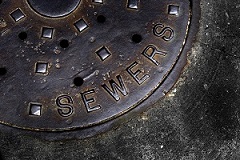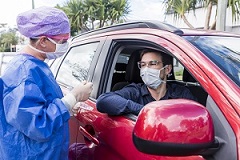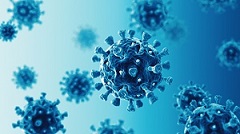Research on COVID-19 in the Environment
Related Resources
Modeling SARS-CoV-2 Aerosols and Evaluating Inactivation Techniques
Detecting and Monitoring SARS-CoV-2 in Wastewater
Evaluating SARS-CoV-2 Cleanup and Disinfection Practice
Developing a Salivary Antibody Test for SARS-CoV-2
EPA researchers are building on an expansive body of world-class research by applying that knowledge to reduce the risk of exposure to SARS-CoV-2, the virus that causes COVID-19. This research will help states, tribes, local, and territorial governments, including public health agencies, guide homeowners, business owners, and workplace managers to reduce the risk of exposure to SARS-CoV-2.
Modeling SARS-CoV-2 Aerosols and Evaluating Inactivation Techniques
EPA researchers are studying SARS-CoV-2 aerosols including fate and transport in an office environment, in a mass transit setting, and evaluating potential aerosol disinfection device technologies in various scenarios.
Research Projects:
- Modeling Transport of Viral Aerosols in an Office Setting
- Modeling Transport of Viral Aerosols in Mass Transit
- Evaluating Pesticide Devices and Products to Inactivate Aerosolized Virus and Reduce Potential Transmission
Read more: Modeling SARS-CoV-2 Aerosols and Evaluating Ways to Inactivate Aerosolized SARS-CoV-2
Detecting and Monitoring SARS-CoV-2 in Wastewater
EPA Research Partners
 Researchers at EPA and the CDC are developing and applying methods for measuring SARS-CoV-2 levels in wastewater. Once developed, the methods will be used to determine infectivity, persistence, and treatment efficacies related to SARS-CoV-2 in wastewater.
Researchers at EPA and the CDC are developing and applying methods for measuring SARS-CoV-2 levels in wastewater. Once developed, the methods will be used to determine infectivity, persistence, and treatment efficacies related to SARS-CoV-2 in wastewater.
With an infectious disease like COVID-19, people may be contagious before they show any symptoms. Preliminary research indicates that monitoring wastewater for the presence of SARS-CoV-2 may be useful as a sensitive early indicator of low levels of infections in the community. Having an early warning system to alert public health officials about infection in a community would be helpful. Likewise, monitoring SARS-CoV-2 in wastewater may also provide an indication of decreasing levels of infection within a community.
In addition, while the risk to utility workers is considered low, there is still value in measuring the levels of virus in wastewater to better understand potential risks from exposure to untreated sewage.
Science Matters Newsletter
Research Projects:
- Standardize Methods to Assess Virus in Sewage
- Monitor Virus Levels in Sewage to Assess Community Infection Rate
Read more: Assessing SARS-CoV-2 Virus Levels in Sewage
Evaluating SARS-CoV-2 Cleanup and Disinfection Practices
 Reducing the risk of exposure to SARS-CoV-2 relies on effective cleaning and disinfection, along with continued social distancing practices. EPA researchers are working on determining the best environmental sample collection methods and the limits of detection for SARS-CoV-2 on surfaces and objects. The researchers will also evaluate microbial disinfectants and application methods for surfaces and objects that are frequently touched by multiple people.
Reducing the risk of exposure to SARS-CoV-2 relies on effective cleaning and disinfection, along with continued social distancing practices. EPA researchers are working on determining the best environmental sample collection methods and the limits of detection for SARS-CoV-2 on surfaces and objects. The researchers will also evaluate microbial disinfectants and application methods for surfaces and objects that are frequently touched by multiple people.
EPA researchers will evaluate innovative ways to disinfect large spaces. Possible approaches include using alternative methods to kill viruses such as ultraviolet light, ozone, and steam, and promising disinfectant application methods such as electrostatic sprayers or foggers. To determine the effectiveness of these approaches, researchers are also developing a method to quickly analyze surface samples for the live virus, both before and after the disinfection process.
The outbreak of COVID-19 has caused shortages in personal protective equipment (PPE), including N95 masks. If shortages continue, having the ability to disinfect PPE without impacting its effectiveness will be critical for hospitals, nursing homes, and essential workers. EPA researchers will evaluate methods of disinfecting used PPE and evaluate whether the methods damage the PPE.
Research Projects:
- Surface Sampling Efficiency
- Real-World Surface Disinfection
- Alternative Disinfection Devices
- Rapid Viability - Reverse Transcriptase Polymerase Chain Reaction
- Disinfection of PPE Intended for Reuse
- Longer-Term SARS-CoV-2 Disinfection Evaluation
Developing a Salivary Antibody Test for SARS-CoV-2
 EPA researchers are working with researchers at CDC to develop a simple, easy, low cost, non-invasive antibody test using saliva samples. Antibody testing helps identify people who have been exposed to SARS-CoV-2, may not have ever developed symptoms, and who have subsequently developed an immune response. Such an antibody test could help public health officials determine the rate of infection across the country.
EPA researchers are working with researchers at CDC to develop a simple, easy, low cost, non-invasive antibody test using saliva samples. Antibody testing helps identify people who have been exposed to SARS-CoV-2, may not have ever developed symptoms, and who have subsequently developed an immune response. Such an antibody test could help public health officials determine the rate of infection across the country.
Research Project:
- Salivary Antibody Assay to Assess Community Exposure
Read more in our Science Matters Newsletter: EPA Researchers are Evaluating SARS-CoV-2 in the Environment

